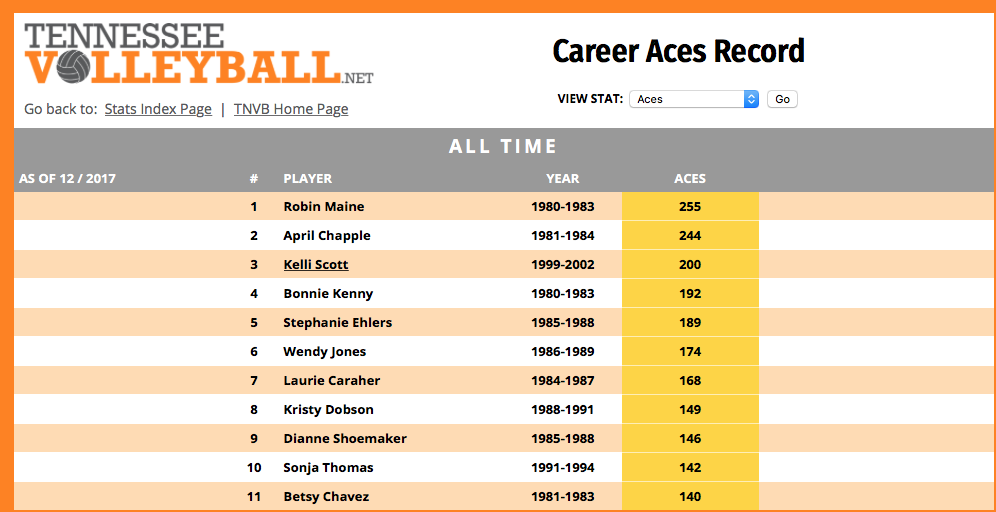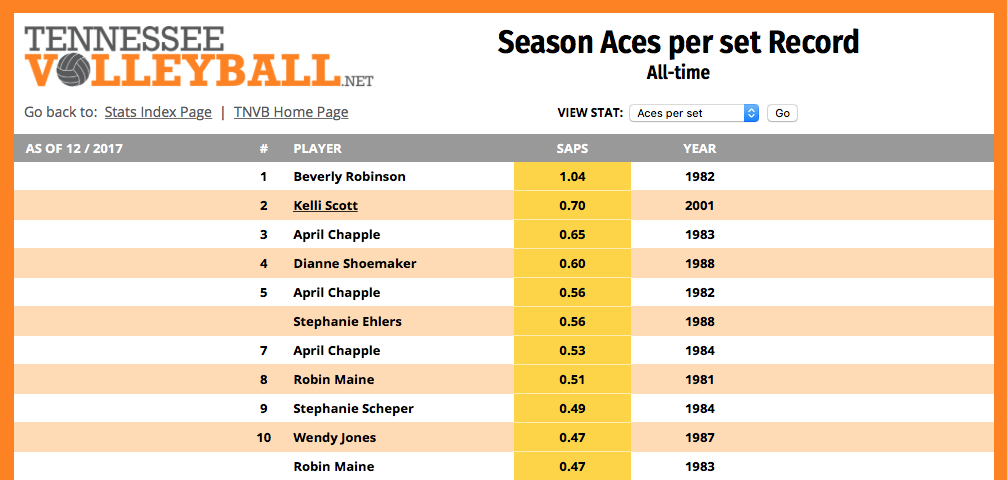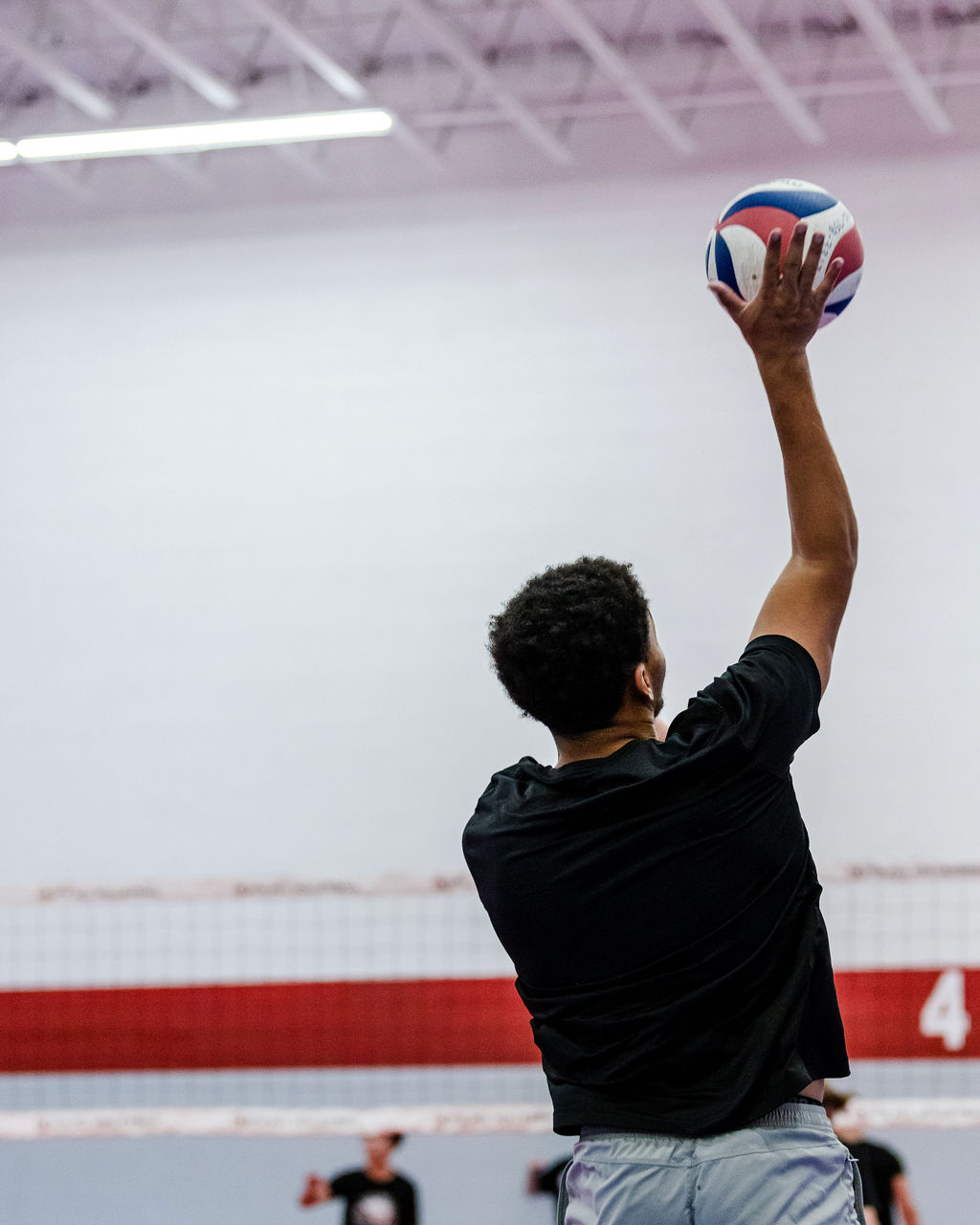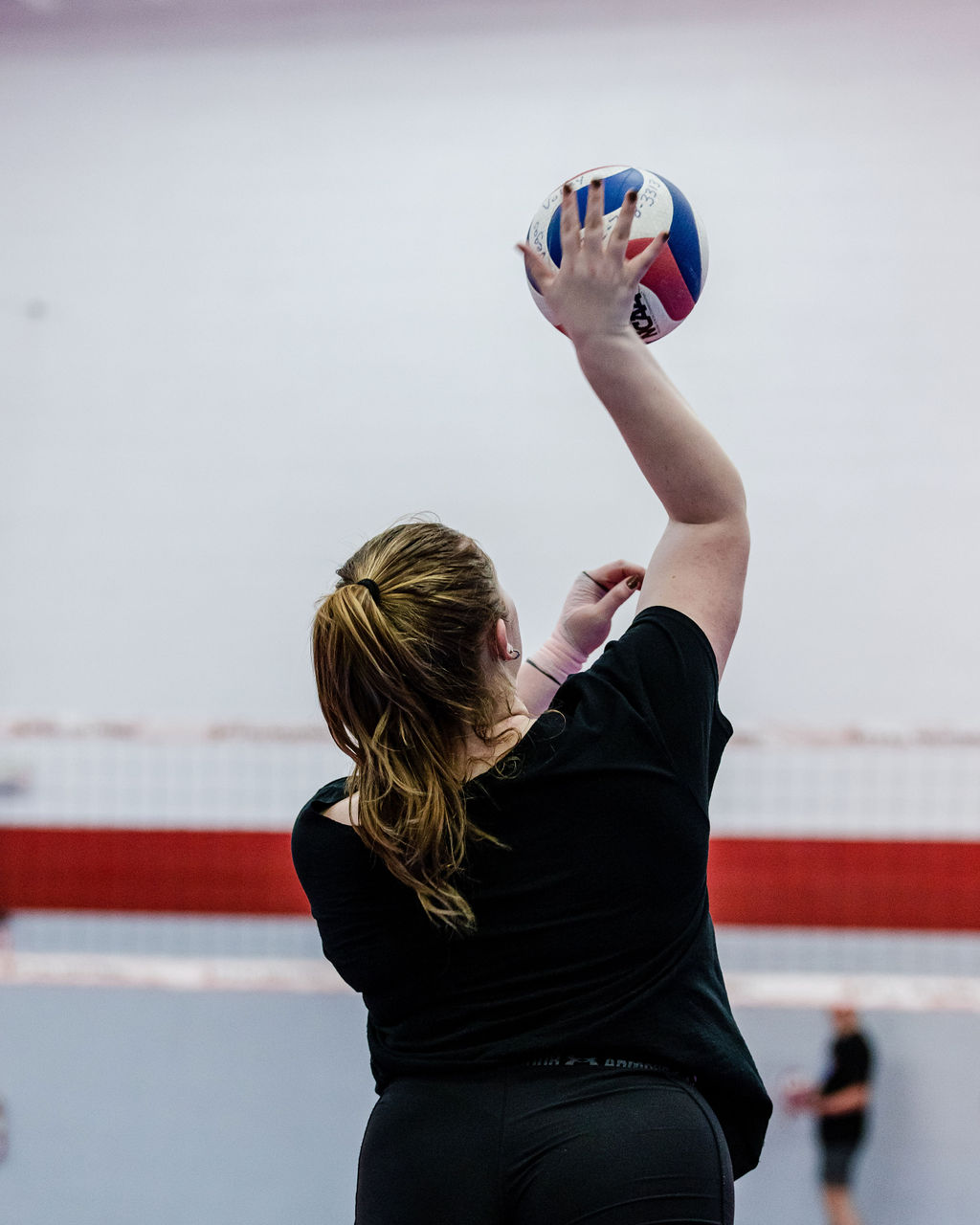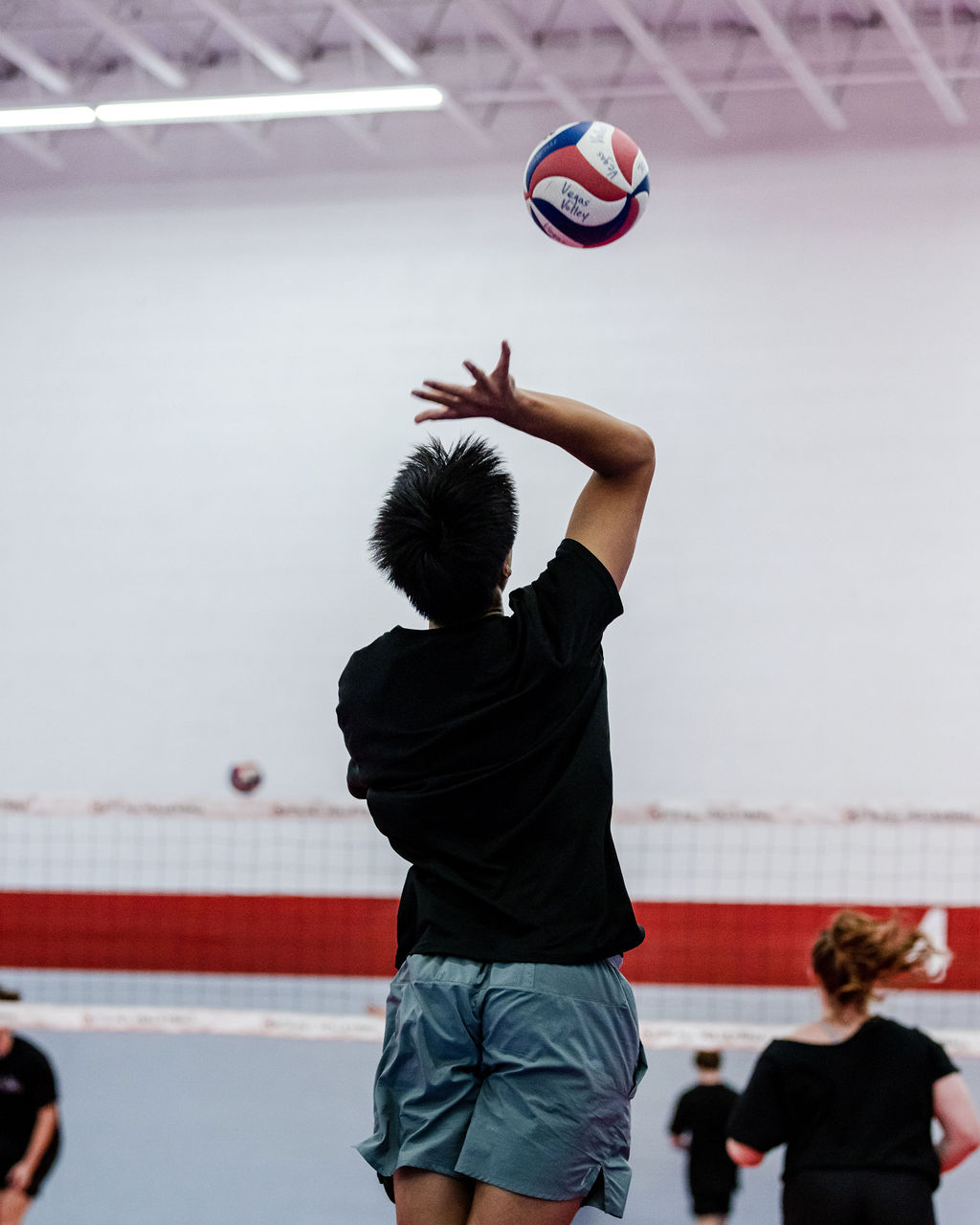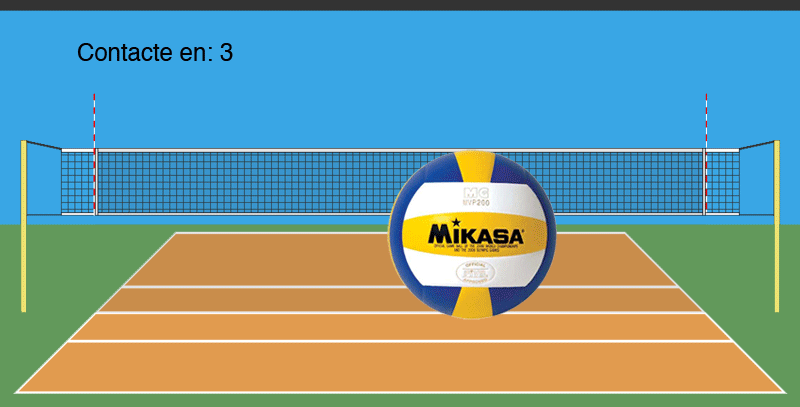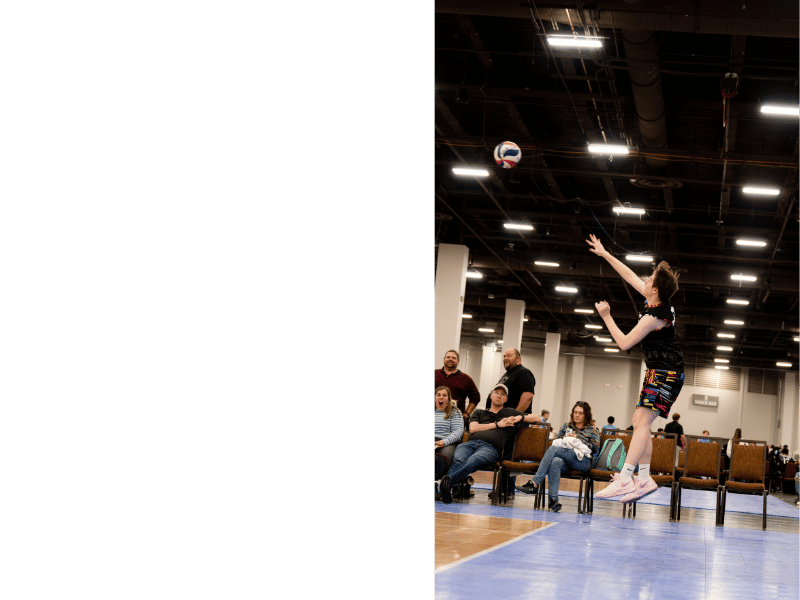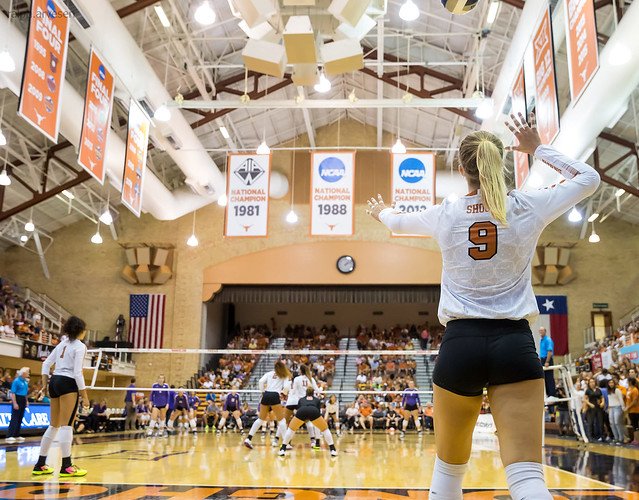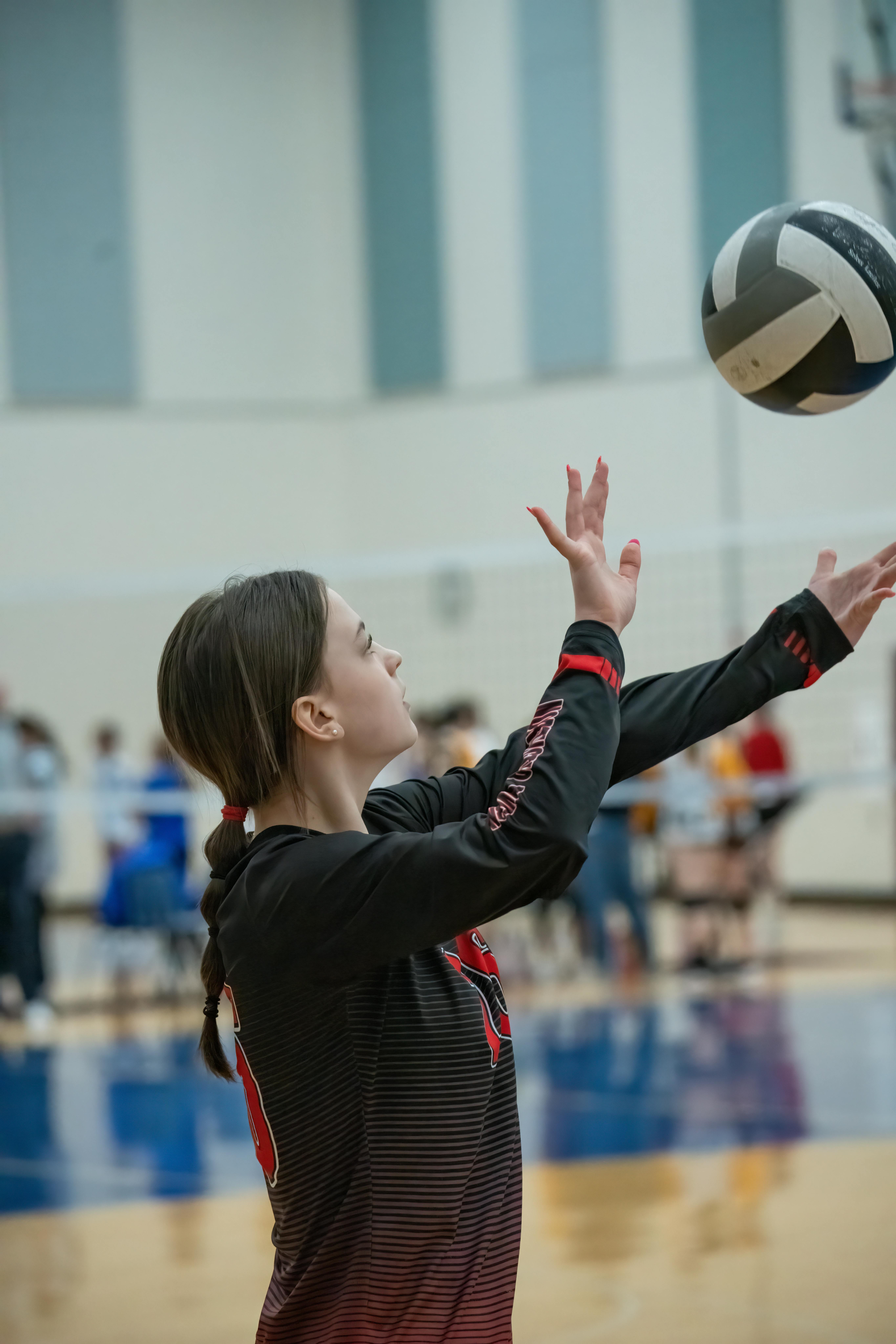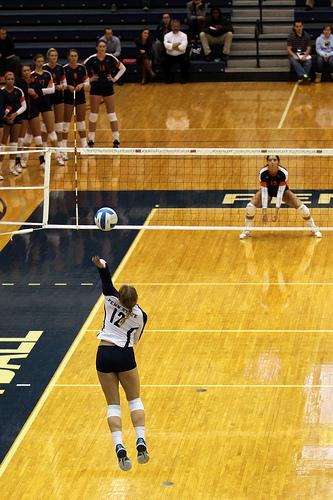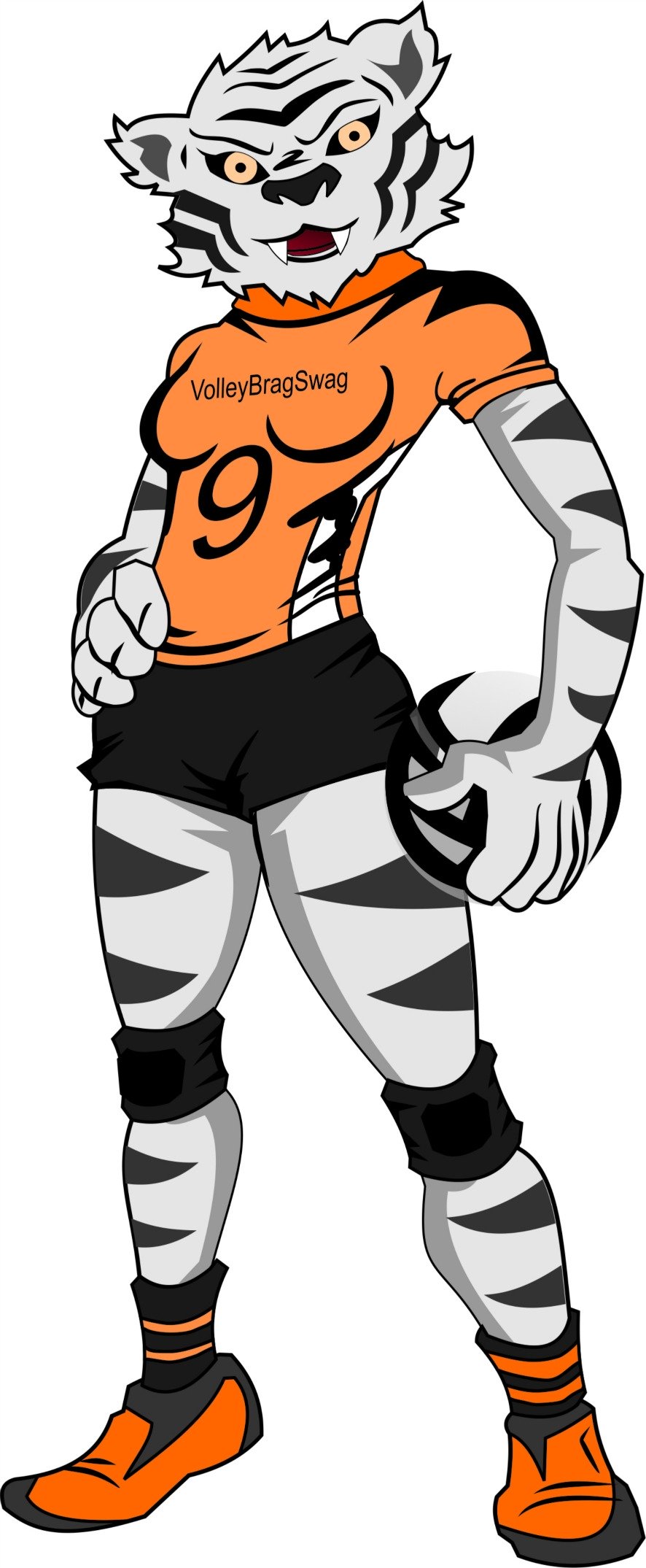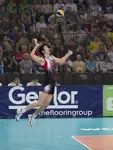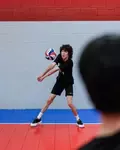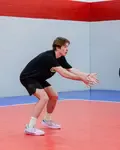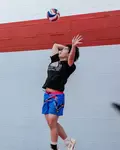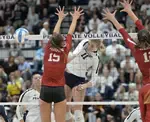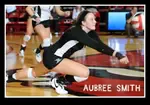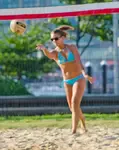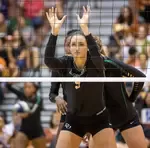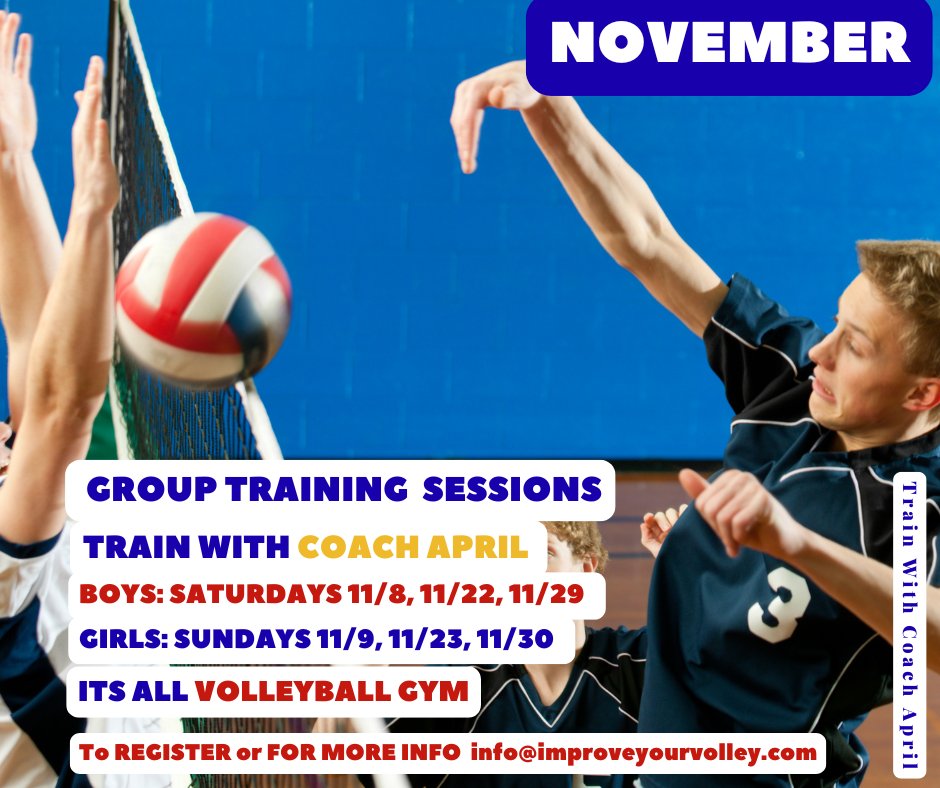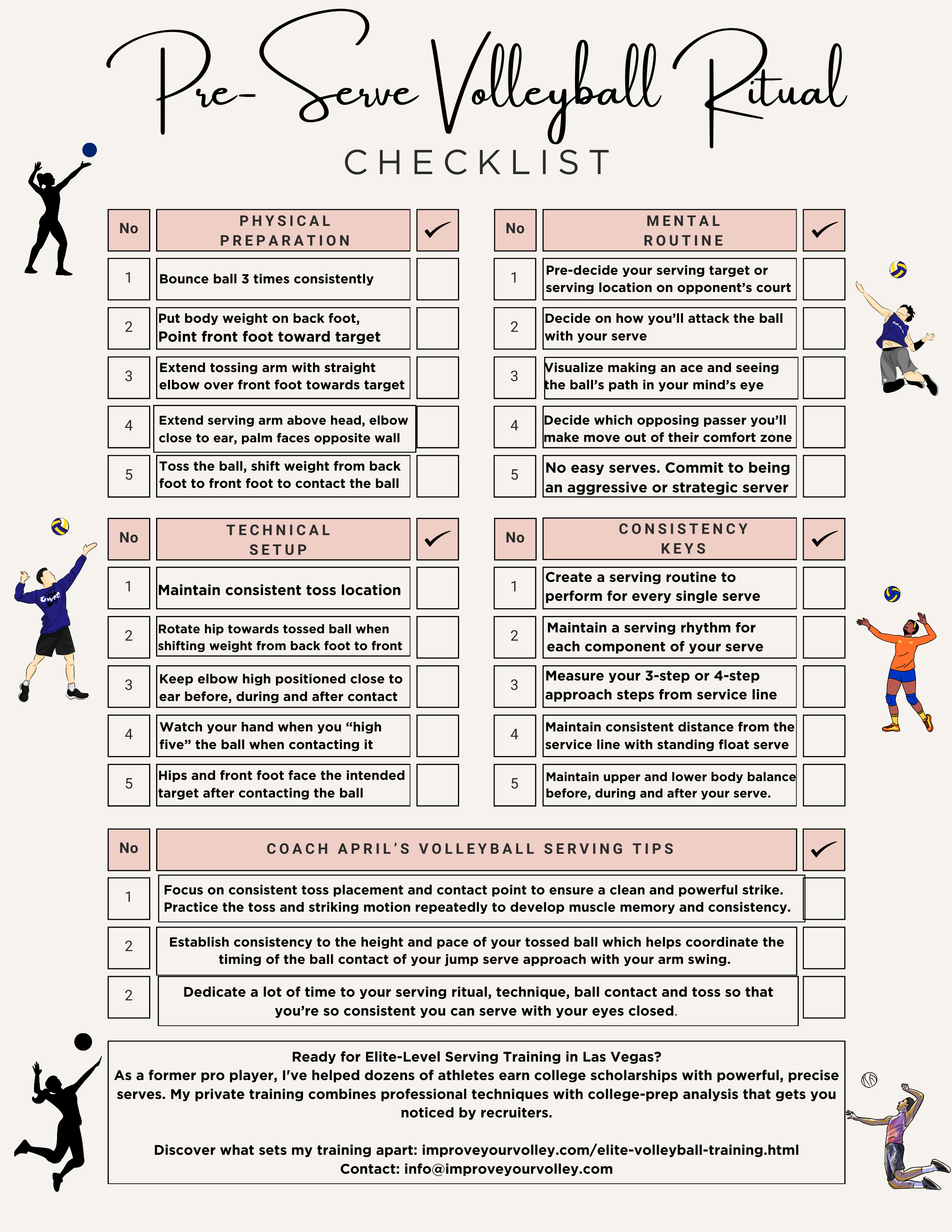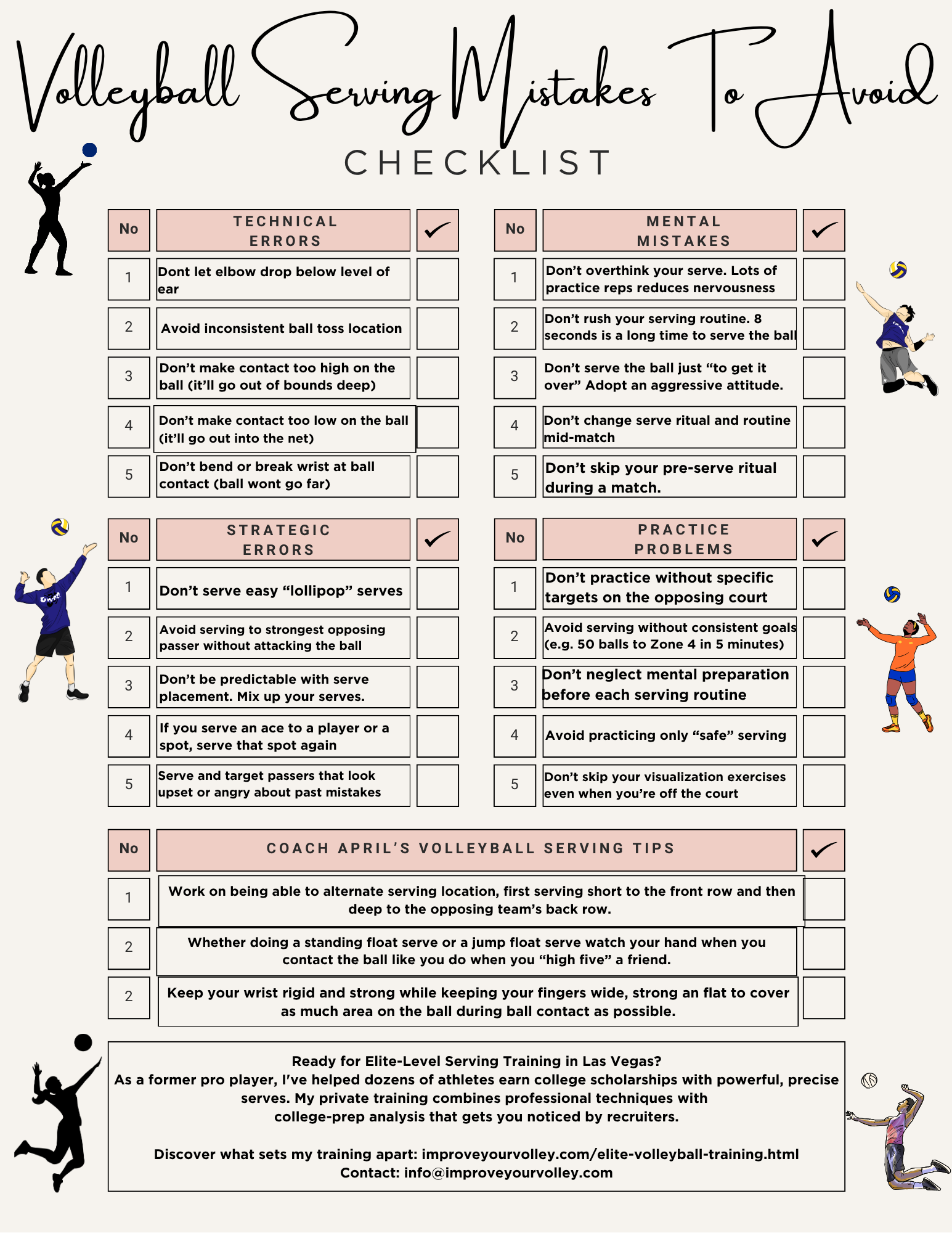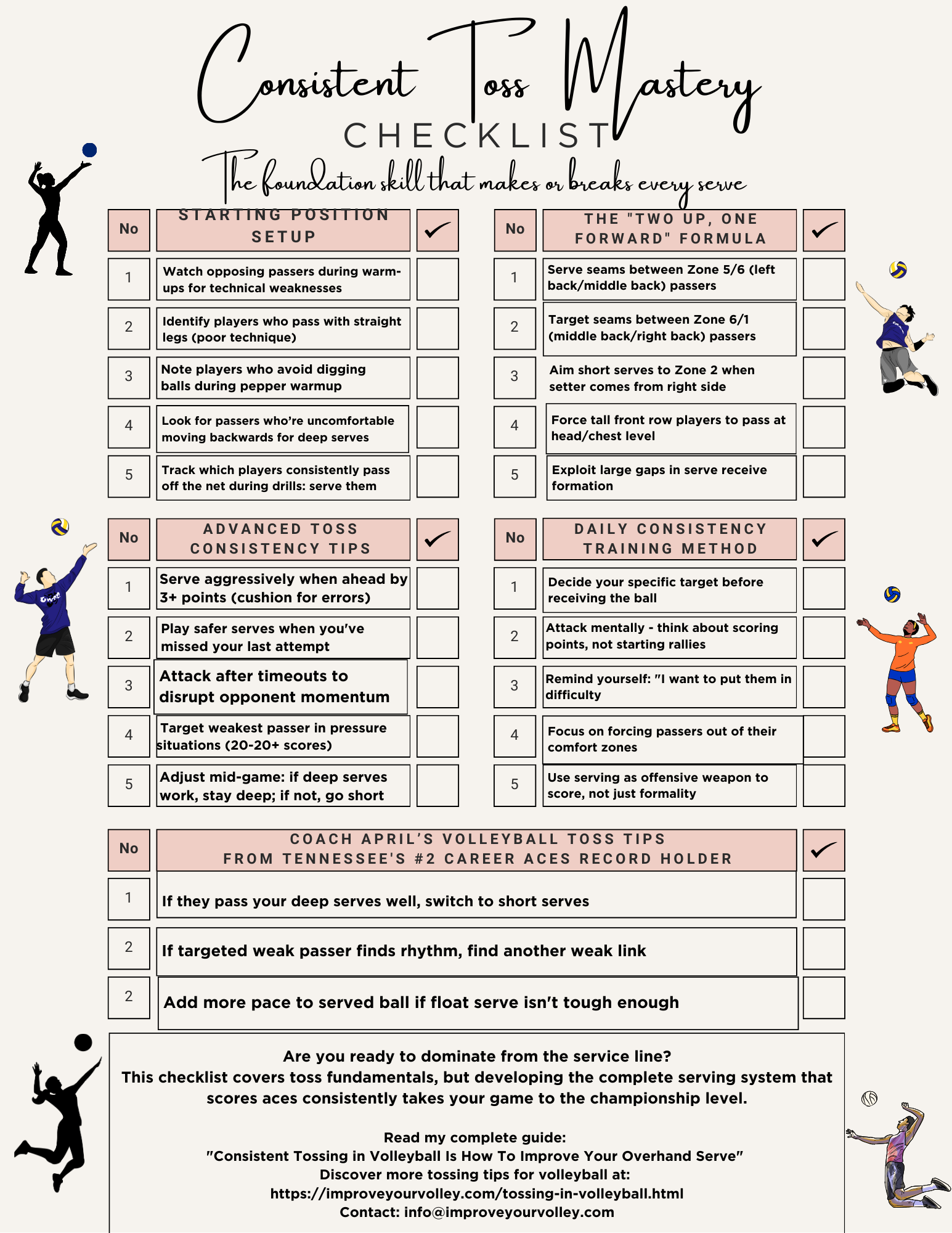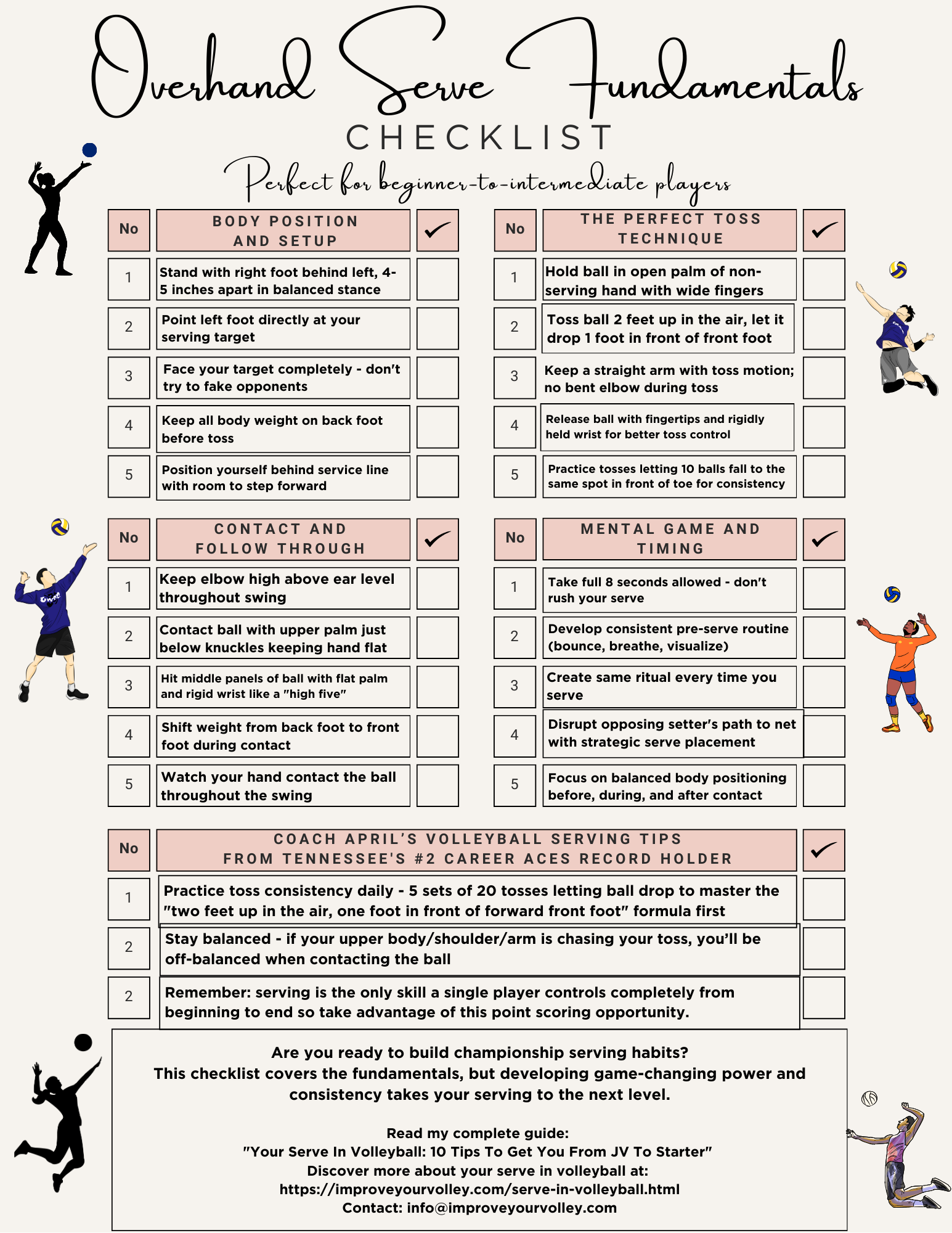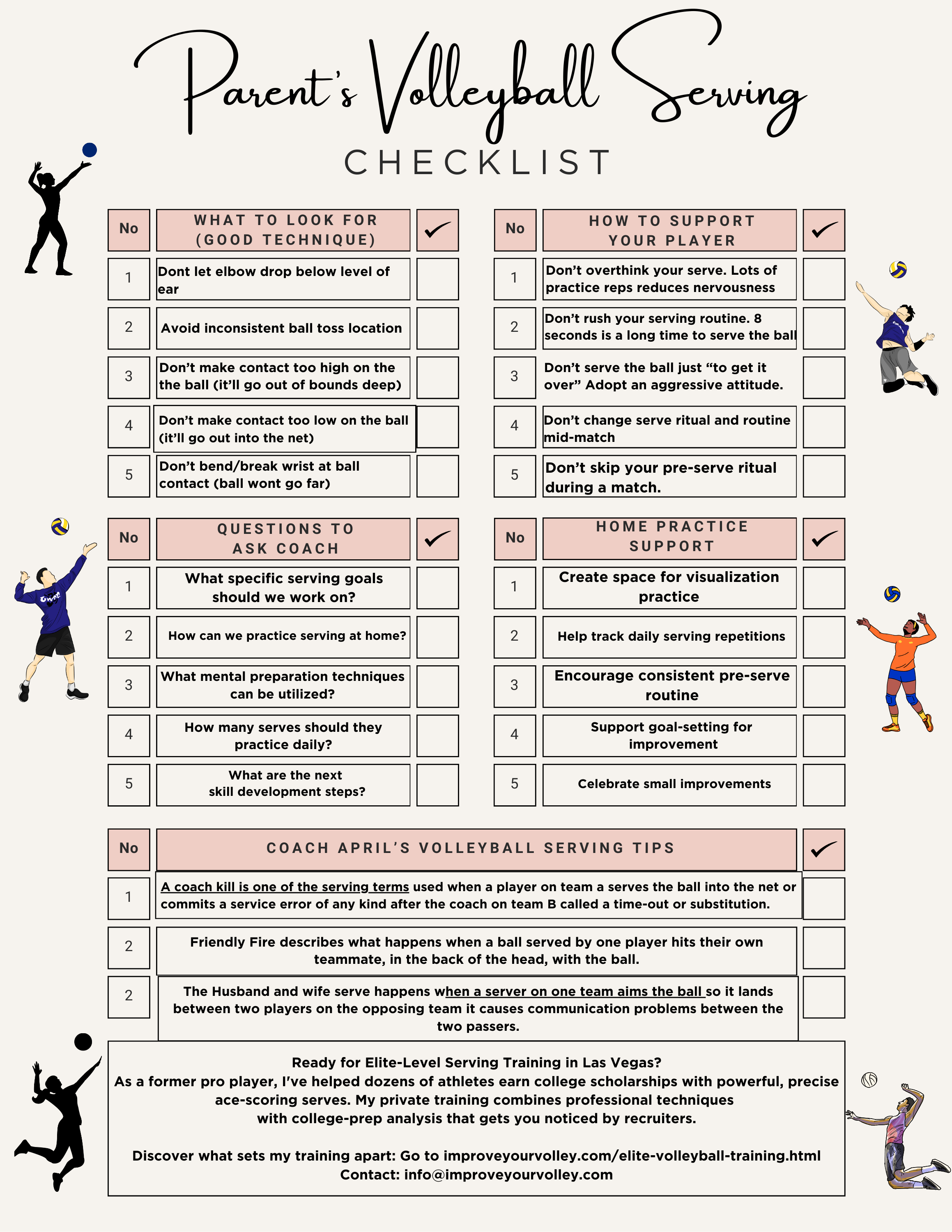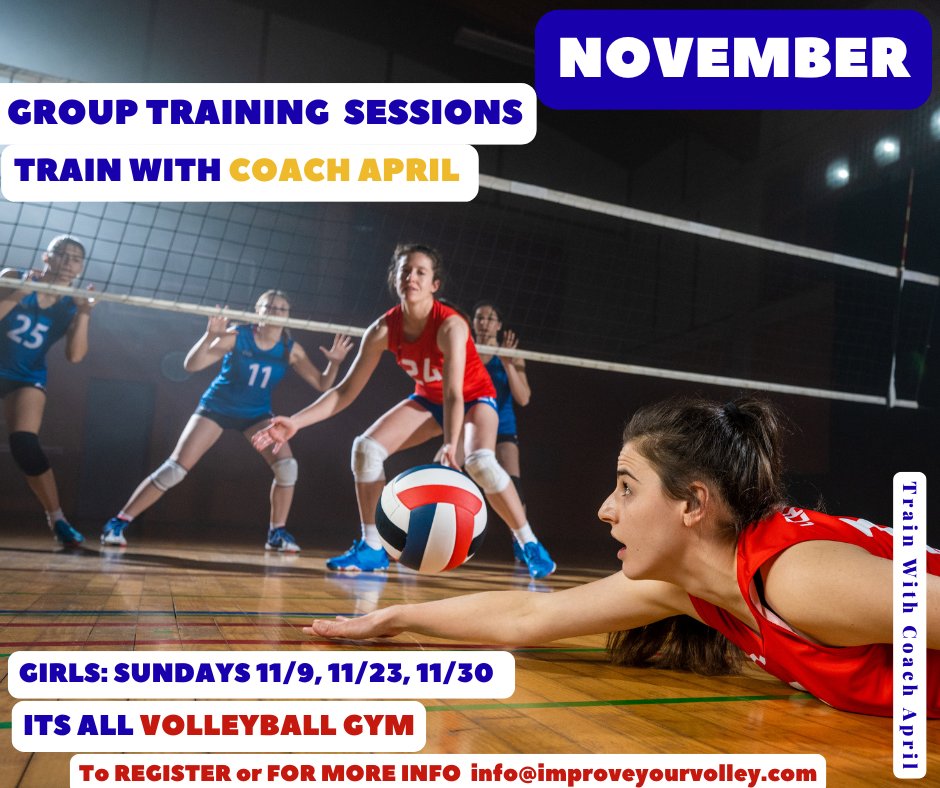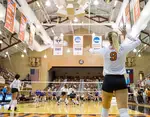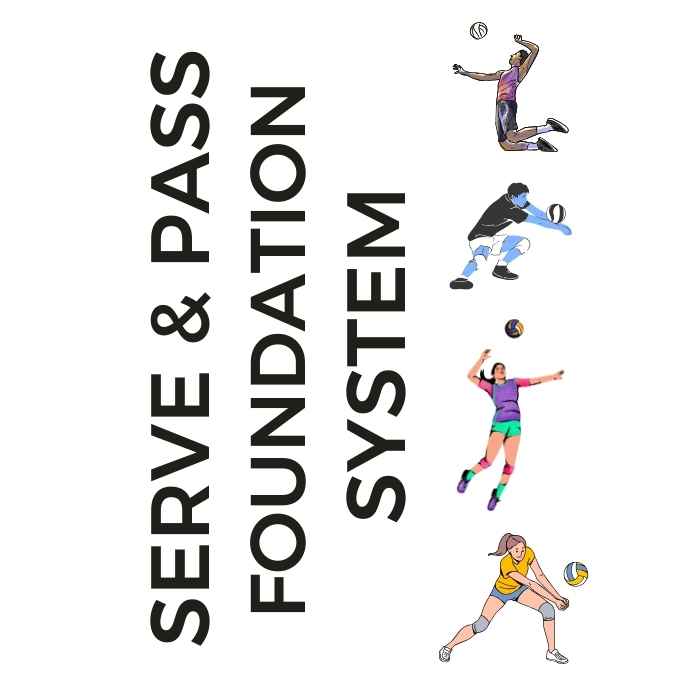
Serve + Pass Foundation System: The Complete Skills Arsenal The two-skill mastery system that transforms inconsistent players into the athletes coaches build their lineups around. Stop Struggling With The Two Most Important Skills In Volleyball!
- Improve Your Volleyball with Coach April
- Basic Volleyball Skills for Beginners
- Good Volleyball Serve
Good Volleyball Serve Secrets: How Bench Players Earn Playing Time
My 40-year serving records still stand at Tennessee. Last month I coached 7 state championship final participants. Do you think you have a good volleyball serve? Here's what championship serving actually looks like.
Here's a stat that will shock you.
Players with 'good' serves get 3 times more playing time than those with 'okay' serves.
Yet a high percentage of high school and club players never learn what actually makes a serve 'good.'
They think (or are led to believe) it's important just to get the ball over the net.
They're wrong.
I learned this the hard way in high school.
I got started late playing volleyball as a sophomore in high school so for a long time that year I thought my serve was 'good enough' because it went over the net.
Then I sat on the bench watching players with weaker arms but smarter serves start ahead of me or get more playing time because I was subbed out since my serves weren't that effective.
Now let me tell you a story.
Once upon a time I attended the University of Tennessee, Knoxville on a partial volleyball scholarship, and when I left I earned a full scholarship, and established career, individual and season records that still hold today, 40 years later.
Focusing on learning how to have a consistently good volleyball serve helped me set career and All-Time records that still exist today in the Career Aces Record and the Seasons Aces per Set record category at the University of Tennessee Knoxville.
I hold the #2 career aces record at the University of Tennessee, Knoxville (244 aces) - a record that's stood for 40+ years.
I also coached 7 players who play for three different high school teams and who participated in two different divisions of Boys state championship finals during the month of June.
I can confidently say that when I tell you what makes a good volleyball serve, you should probably listen.
When you look at my players you'll see that all of them have the same good volleyball serve form and technique.
We work hard on -
- keeping the elbow close to the ear
- watching their hand when they contact the ball
- watch how their hips are facing where they want to serve the ball (we were working on serving line to zone 5)
- all of them are or will contact the ball at the same spot on the ball, so the upper part of the palm just below the knuckles contact the middle panels of the ball
- working on a consistent toss on every serve so I know exactly where to contact the ball
When you hold serving records that have lasted 40+ years, you understand what a 'good' volleyball serve really means.
Most players think good is 'getting it over.'
I averaged .65 aces per set in 1983 - that's what good actually looks like.
Okay enough about me, lets talk about you.
Learning how to do the proper technique is important for a consistently good volleyball serve that scores points.
Regardless of the type of serve you choose, the following elements are crucial.
What Defines a Good Volleyball Serve: The 5 Non-Negotiable Standards
If you could only master 5 serving qualities, wouldn't you want to know which ones coaches value most?
When you hold serving records that have lasted 40+ years, you understand what 'good' really means. Most players think good is 'getting it over.' I averaged .65 aces per set in 1983 - that's what good actually looks like.
After establishing and still holding a 40-year-old record of winning three (3) Southeastern Conference title championships in four years and now this year (after many) coached seven (7) of my 18s boys team players representing three different high school teams compete in two divisions of state final championships last month...I can tell you exactly what separates good servers from average ones.
- It's not power.
- It's not luck.
It's meeting these 5 non-negotiable standards.
Standard #1: Consistency Above All Else
Here's an irrefutable truth: Would you rather have a server who hits 5 aces and 5 errors, or one who serves 9/10 in bounds with strategic placement? Every coach chooses consistency.
A good volleyball serve means you can deliver under pressure, when tired, and when the game is on the line.
Your Standard: 85% in-bounds accuracy in practice, 80% in games
Standard #2: Strategic Placement Over Random Power
Think about this: If you could place your serve anywhere on the court, would you aim randomly or target weaknesses?
Good servers always have a plan.
During my SEC championship years, I didn't just serve hard - I served smart. Zone 1 when their setter was back row. Short serves when their passers were deep. Seams between players who didn't communicate well.
Your Standard: 70% of serves should target specific zones or players
Standard #3: Movement That Disrupts Passing
Ask any libero: What's harder to pass - a fast serve with no movement or a slower serve that moves unpredictably? The answer is always movement.
My float serves in the 1980s moved because I understood the physics and hand on ball placement.
Clean contact, firm wrist, minimal spin.
The same technique I teach my Vegas Volley players who just dominated their tournaments.
Your Standard: Your serves should move enough to challenge even good passers
Standard #4: Adaptability Mid-Game
Here's what separates good from average:
Can you adjust when your initial serving plan isn't working?
Good servers read the game and adapt.
If they're passing your deep serves well, can you serve short?
If they've adjusted to your target player, can you find their second weakness?
This adaptability helped me maintain my .65 aces per set average across multiple seasons.
Your Standard: Have at least 3 different serving options ready
Standard #5: Mental Composure Under Pressure
The ultimate test: Can you serve well when everyone is watching?
When the score is tied?
When you missed your last serve? Mental toughness separates good servers from great ones.
I served for three SEC championships. My recent players served in state finals. The pressure doesn't change - only your preparation for it does.
Your Standard: Practice serving in pressure situations regularly
The Reality Check
Most players think they have a "good" serve because it goes over the net.
But when you measure against these 5 standards, how does your serve actually stack up?
Be honest: Do you meet all 5 standards consistently?
If not, you don't have a good serve yet - you have a developing one. And that's okay, because now you know exactly what to work on.
What is A Good Volleyball Serve?
Float Serve Grip
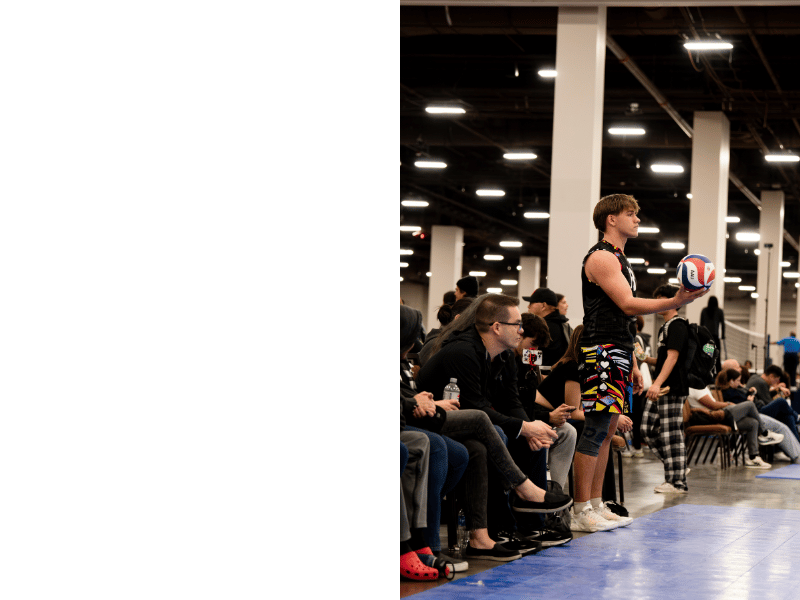 For the float serve, it's important to have a loose and relaxed grip on the ball. Place your tossing hand underneath the ball, allowing your fingers to spread naturally.
For the float serve, it's important to have a loose and relaxed grip on the ball. Place your tossing hand underneath the ball, allowing your fingers to spread naturally.For the float serve, it's important to have a loose and relaxed grip on the ball.
Place your tossing hand underneath the ball, allowing your fingers to spread naturally.
Keep your hand and wrist relaxed to avoid generating excessive spin on the ball.
This type of grip promotes a clean surface contact with the ball, allowing it to float unpredictably over the net.
What is A Good Volleyball Serve?
Jump Serve Grip
With the jump serve, a firmer grip is recommended to generate power and control.
Hold the ball firmly in the palm of your hand and use your fingers to secure it in place.
Maintain a steady grip throughout your serving motion to ensure that the ball doesn't slip from your hand.
This grip helps maximize your ability to impart spin and power on the ball.
What is A Good Volleyball Serve?
Topspin Serve Grip
A 12-year old with a tough top spin jump serve!
The topspin serve requires a strong yet controlled grip on the ball. Hold the ball tightly with your palm and fingers.
Keep your hand slightly behind the ball to allow for a clean strike and effective topspin rotation.
The firm grip helps you generate the necessary spin to create a downward trajectory and make it difficult for the opposing team to handle.
Regardless of the serve type, it's crucial to find a grip that feels comfortable and natural to you.
Experiment with different grip pressures and positions to discover what works best for your serves.
Remember, a balance between a firm grip and maintaining a relaxed and fluid motion is key to executing accurate and powerful serves.
By emphasizing the importance of a firm yet comfortable hold on the ball, players can optimize their serve technique and improve their overall serving performance.
Common Serving Mistakes
To help players avoid common pitfalls, I address some common serving mistakes and provide tips on how to rectify them in order to insure you consistently make a good volleyball serve.
Some examples include:
What is Not A Good Volleyball Serve? Serving into the Net
Explain the common causes of serving into the net and offer techniques for creating the necessary height and clearance.
What is Not A Good Volleyball Serve?
Serving Long or Out of Bounds
Discuss the importance of proper aim and provide suggestions on adjusting power and technique to achieve better control.
Good Volleyball Serve Strategies and Tactics To Use During A Match
During a match you as the server can use certain strategies of serving that can give you an advantage during a match.
Some strategies to consider include:
- target weak zones on the court
- mix up your serves
- learn to read your server's body language
Tips On How To Develop A Good Volleyball Serve
Target Weak Zones
-Targeting Weak Zones
During warmups you get a chance to see how players pass and that's the time to identify who has strong passing skills.
Serving deep to the opposing team's cross court to zone One when the setter is backrow in defense in Zone One is always a good volleyball serving tactic to use because the passer has to pass a perfect ball from the right back of the court ..in front.. of the setter... who is moving to the net ...while having to turn and look over their shoulder ...in order to deliver a good set to their hitter.
If they dont pass well, the setter has to work harder to get to the ball...and the set becomes an easy ball for your team in defense to dig because the hitter doesn't get a good set.
All this chaos is the result of a smartly placed serve from you.
Tips On How To Develop A Good Volleyball Serve
Varying Serves: Change Things Up!
-Varying Serves
In practice you want to learn to mix up your serves. My teams regularly know how to serve short in one rally and then serve deep in another rally which keeps the opposing team's passers guessing all the time.
Tips On How To Develop A Good Volleyball Serve
Read The Opponent's Positioning
How To Create A Good Volleyball Serve?
Read The Opponent's Positioning
Learn to watch and identify where the opposing team's passers are in their serve receive formation on their court.
If the opposing team's passers are standing closer to the ten foot line then consider aiming your serve either at their heads or deeper in the court so they're forced to move backwards.
Serving Tips for Beginners That Want To Develop A Good Volleyball Serve
Addi working on her standing floater in volleyball serve down the line.
Focusing on starting with hips open to the wall to her right, a consistent toss and a smooth arm swing when contacting the ball with the middle of her hand to the middle of the ball.
For beginners who are just starting to learn the serve, here are some tips and advice to help you improve your skills.
- focus on consistency
- start with a basic serve
- practice regularly
How To Create A
Good Volleyball Serve?
Focus on Consistency
- Focus on Consistency
As a beginner you want to practice your reps so that you develop consistent technique and repetition to develop muscle memory.
Players are given a specific amount of time to serve a pre-determined number of balls to the target area formed by the chairs. hitting the middle of the chairs is rewarded more than just hitting the chairs in this case but coaches can come up with their own rules in irder to make this a tougher or easier drill.
If you get 15 to the target out of 30 total attempts that means you made half of them or 50% of your serves to the target.
Every time you practice at home by yourself see if you can do better than 50%..This is how you can test yourself each time and how you can keep track of your improvement.
Serving Tips for Beginners That Want To Develop A Good Volleyball Serve
Start With A Basic Serve
- Start with a Basic Serve
If you're a beginner you'll probably start with a fundamental serve technique, such as an underhand serve or a simple standing overhand serve, before moving onto more advanced types of serves in volleyball.
Get consistently good with your simple serve before moving on to more advance types of serves in volleyball.
Serving Tips for Beginners That Want To Develop A Good Volleyball Serve
Practice Regularly
- Practice Regularly
Practice, practice and practice your serve.
The serve is the one skill you by yourself control and can use to score points without the help of a coach or a teammate so wouldn't you want to get back behind the service line and confidently serve as many points for your team as possible?
The only way to be able to consistently do that is to practice serving to consistent spots to the opposing court so that at any stressful time during a match you are calm enough and consistent enough to serve tough no matter what.
Players are given a specific amount of time to serve a pre-determined number of balls to the target area formed by the chairs. hitting the middle of the chairs is rewarded more than just hitting the chairs in this case but coaches can come up with their own rules in irder to make this a tougher or easier drill.
Frequently Asked Good Volleyball Serve Questions Answered
As the #2 career aces leader at the University of Tennessee - a record that's stood for 40+ years - I see these serving questions constantly on r/volleyball. Here are answers from someone who actually dominated at the highest level:
Which team can serve the ball first?
- The team that wins the coin toss at the beginning of a match is the team that can serve first.
How many players can serve a ball and when?
- Only one player can serve the ball at the beginning of a rally.
Who can serve the ball?
- The player on the offensive team, who starts in Zone 1, is the only one who can serve the ball.
Where can you serve the ball from on the court?
- The server must be behind the service line until the ball has been contacted.
What is the purpose of the volleyball serve?
Each official match must
- begin with a serve from one team
- which is sent into the opposing team's court with
- the intent on starting the rally and possibly scoring a point.
What Is A Good Volleyball Serve? Learn from a Serving Legend
How Do You Go From Bench Warmer to Game Changer?
Here's a question every player needs to answer:
Would you rather watch from the sidelines or be the player coaches trust in crucial moments?
The difference usually comes down to one skill - serving.
Think about it: If you could master just ONE skill that guarantees more playing time, wouldn't you want to know what it is?
let me repeat what I said earlier.
I've been creating serving legends since 1981.
My own personal serving records at the university of Tennessee Knoxville still stand because the fundamentals never change.
My 2024 state champions, state championship runners up, All State and All Conference players prove these techniques work at every level.
Want to transform your serve from liability to weapon?
My Volleyball Serving Ebook reveals 40+ years of serving secrets. Or skip the learning curve with Private Training with Coach April. Because isn't earning your spot on the court worth investing in?
Because when tryouts are 17 days away, shouldn't you learn from someone whose methods are proven to work?
Do You Follow Me on Pinterest?
Follow me on Pinterest Volleybragswag to improve your game even faster!
I share alot of individual, partner and easy-to-do volleyball serving drills we do in class with my followers.
Many of these volleyball practice drills you can do at home by yourself or try at your next practice with your teammates.
If you're a B team or JV player trying to make varsity next year...your goal should be to complete 1000 reps a day of at least three of the basic skills on your own...volleyball passing, serving and setting should be at the top of the list.
What Is A Good Volleyball Serve
Where Do You Go From Here?
Your three options are:
- You can learn more about Serving by visiting the related links below.
- Follow the suggested reading on our Sitemap page Learning How To Play (Sitemap)
- Or visit the pages in the How to Play Volleyball section in the drop down menu at the top of the page to get started.
- Before leaving this page Say "Hi" to Miss Tattoo the Tiger wearing the #9 jersey below. Miss Tattoo is the starting defensive and serving specialist for the All Beast VolleyBragSwag All Star team.
Meet Tatoo the Tiger, Serving Specialist on VolleyBragSwag's All Beast Team
If your athlete struggles with consistent serve receive, gets subbed out, or is overlooked for playing time—this is the fix you’ve been looking for.

Struggling with passing consistency?
I help talented passers tired of getting pulled from games because of inconsistent serve receive skills BUILD passing confidence without expensive private lessons using the same 3-step system that's helped dozens of my athletes get recruited.
Download my eBook for $17.99 and start building the passing confidence that keeps you on the court—and gets you seen by college coaches.
From Lady Vol to Legend: Coach April Produces Powerful Passionate Players...is that you?
What Are You Looking For?
Click to Download Your Pre Serving Ritual Mastery Checklist pdf:
🎯Volleyball Pre Serving Ritual Guide -
Players! Learn How To Transform Your Serve from Weak to Weapon
Click to Download Your Parent's Volleyball Serving Checklist pdf
🎯Parent's Volleyball Serving Checklist Guide
Parents! Help Your Player Develop Championship Serves (Even If You've Never Played)

Hi there!
Thanks for stopping by. Hope you learned something today that will help you reach your volleyball goals.
Be sure to subscribe to my email newsletter so you can learn more each week!
Stay strong! Stay motivated!
-Coach April

SUSCRIBE to my email newsletter below!
 Click to learn more about the weekly volleyball classes and clinics or email info@imrpoveyourvolley.com for information
Click to learn more about the weekly volleyball classes and clinics or email info@imrpoveyourvolley.com for informationCongratulations to my seven Boys-18s Vegas Volley club players who played in two state championship finals yesterday, the 3A and 5A State champinship finals at Sunrise Mountain High School.
TOURNAMENT CHAMPIONS!
A-1 Vegas Volley VBC
In It To Win It Tournament
May 2 - 4, 2025 Tournament
Gold Medalists
18s Premier Division
Vegas Volleyball's Unsung Heroes: Celebrating Moms with Peace Love Volleyball Shirts
Ready to energize your volleyball mom journey?
Subscribe to my 'Producing Powerful Passionate Peaceful Players' email list above on ImproveYourVolley.com.
You'll receive energy-boosting tips, exclusive insights from me, Coach April Chapple on maintaining momentum in volleyball.
Let's power up the Vegas volleyball scene together!
Recent Articles
-
5 Essential Serving Tips from Tennessee's #2 Career Aces Record Holder
Dec 09, 25 11:39 PM
I've identified the 5 essential serving tips that separate confident servers from struggling ones and you'll serve with the confidence that creates aces -
The Volleyball Toss How Consistent Is Your Ball Toss Before You Serve?
Dec 07, 25 12:29 AM
The volleyball toss for the overhand serve needs to consistently be two feet up in the air and one foot in front of front foot which puts the ball in front of your serving arm. -
Shop Small: Real Volleyball Training With + Results From A Real Coach
Dec 03, 25 10:30 AM
Support a woman-owned business. Get training from a former elite pro with 13+ years coaching experience. Ditch the big box store--invest in proven results.
